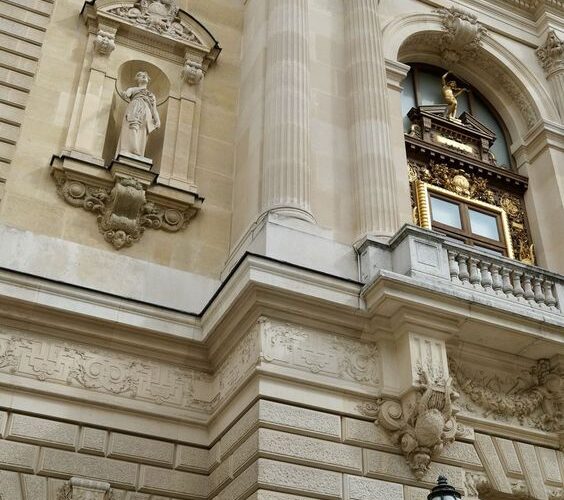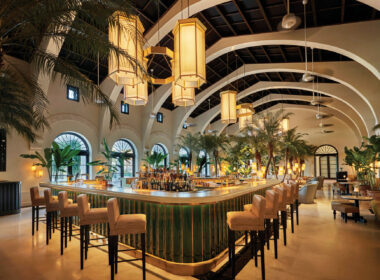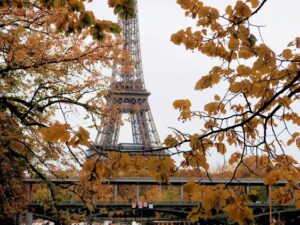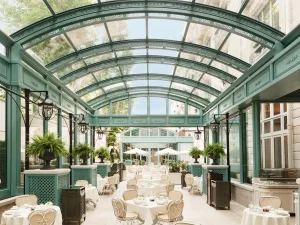A Parisian Opera Lover’s Guide:Opera Houses In Paris

Opera Houses in Paris are a must-visit for any opera fan. The city has an incredible history of opera, dating back to the 17th century. It’s also home to some of the most famous operas ever written, such as Carmen and La Traviata.
The Palais Garnier
The Palais Garnier is one of the most famous opera houses in Paris. It was built between 1868 and 1875 by Charles Garnier, who also designed L’Opéra de Monte-Carlo, Parisian Bibliotheque Nationale, as well as the Palais de la Légion d’Honneur (now known as l’Institut de France).
The opera house was originally constructed for an estimated cost of $20 million dollars–a huge sum at that time–and took over 30 years to complete due to financial issues and delays caused by World War I. The building contains 2,000 seats across four tiers with boxes on either side; there are also two balconies overlooking both sides of stage where patrons can sit during performances if they don’t have tickets for box seats or orchestra seating below them.
The building itself is gorgeous: its interior features richly decorated walls and ceilings, marble columns, gilded statues and more than 4500 square meters of gold leaf! The auditorium seats 2200 people on three levels; it’s designed so that everyone can see everything clearly from any seat in their section–no matter how far away from center stage they sit!
The Palais Garnier hosts many different kinds of performances including ballet performances by both French companies like Les Ballets de Monte Carlo or American ones such as New York City Ballet Company; operas from around Europe such as Vienna State Opera Orchestra & Chorus; symphonic orchestras like Orchestre National de France; jazz ensembles like Kenny Barron Quintet featuring Ron Carter & Walter Smith III plus many more!
The Palais Garnier boasts regular visiting hours, making it accessible for self-guided tours. It’s open daily from 10:00 am to 5:00 pm, with last entry an hour before closing. However, be aware that the auditorium is often inaccessible due to ongoing performances, and some areas may be closed temporarily. It’s always best to check their website (https://www.operadeparis.fr/en/visits/palais-garnier) for any closures or special events before planning your visit.
The Opéra Bastille
If you’re looking for an opera house that’s more modern and less traditional, the Opéra Bastille is your best bet. Located on Place de la Bastille in eastern Paris, this building was built in 1989 as a replacement for another opera house that had been destroyed during the French Revolution. It’s named after its location–a symbolic gesture to honor those who fought against oppression during that time period.
The Opéra Bastille has become an iconic landmark in Paris over its 25 years of existence; it even appears on France’s 100-franc note! Its architecture features include columns made of glass and steel, which give off an airy feel despite being located underground (the subterranean level contains dressing rooms). The outside plaza also hosts events such as outdoor concerts and festivals throughout summer months; if you’re visiting during these times, be sure not only to check out what’s happening inside but also outside!
Performances typically occur in the evenings, with showtimes varying depending on the production. While guided tours are not offered regularly, it’s best to check the Opéra National de Paris website (https://www.operadeparis.fr/en) for any potential guided tour opportunities or special events. For performances, aiming for evenings during the week or weekends is ideal, as that’s when shows are most frequently scheduled.
The Opéra Comique
The Opéra Comique is a theater in Paris, France. It was founded in 1714 and was originally called “Théâtre de Monsieur”. The building was designed by Pierre Bullet.The opera house has been home to many famous composers including Jean-Philippe Rameau and Jacques Offenbach who wrote some of his most famous works here. The building itself is gorgeous with its grandeur and architectural features that make it stand out from other buildings in Paris. Today it hosts operas as well as plays and concerts.
The current state of this magnificent venue is not so great however; there have been plans for renovations since 2007 but nothing has happened yet due to budget issues and lack of political will (or interest).
The Opéra Comique doesn’t have specific visiting hours, as its primary function is hosting performances. However, they do offer guided tours outside of performance times. These tours typically occur on Saturdays, with specific dates and times varying throughout the year. While there aren’t set visiting hours, aiming for a Saturday afternoon visit would be ideal to potentially catch a guided tour and explore the beautiful theater.
The Théâtre du Châtelet
The Théâtre du Châtelet is a grand opera house that has been a fixture of Parisian culture for more than 200 years. It was founded in 1773 as the Théâtre Montansier and has since been home to many notable performances. The current building was constructed between 1864 and 1867, with renovations made in 1912 by Charles Garnier (the architect of the Paris Opera) but its current state is far from what it once was.
The theatre opened its doors on June 1st, 1867 with a performance by Adolphe Adam’s opera La Jolie Fille de Perth starring Pauline Viardot-Garcia who sang the role of Isabelle de Perth opposite Jean-Baptiste Faure as George de Birniere/Jean II d’Auchterlony. Since then it has hosted many notable operas including Mozart’s Don Giovanni, Rossini’s Guillaume Tell, Verdi’s Rigoletto, Massenet’s Manon Lescaut and Puccini’s Tosca.
The theatre was originally designed by Victor Louis, who also designed the Palais Royal and Place de la Concorde. The interior has been described as “one of the most beautiful theatres in Europe” with its lavish décor and architecture that makes use of marble columns, gilded statues and paintings depicting scenes from Greek mythology (alluding to its namesake).
In recent years however it has fallen into disrepair; currently only one third of seats are usable due to concerns regarding safety issues such as falling plasterwork or crumbling balconies!
The Théâtre du Châtelet doesn’t operate with set visiting hours like a museum, as its primary function is hosting performances. Shows typically take place in the evenings, with varying start times depending on the production. To plan your visit, it’s crucial to check the theater’s website (https://www.chatelet.com/) for the specific schedule and showtimes, as they can change throughout the year. While there aren’t specific visiting hours, arriving an hour before the showtime is generally recommended to allow for ticket collection and finding your seat comfortably.
The Théâtre des Champs-Élysées
The Théâtre des Champs-Élysées is one of the most famous luxuryopera houses in Paris. It was built in 1782 and opened in 1784 and has hosted many famous artists, including Mozart and Rossini. The theater also has a rich history: it was built by Louis XV as a venue for his mistress Madame de Pompadour to perform in, but she died before she could perform there.
The building itself is quite grand, with an impressive façade that includes statues of Apollo and Mercury on either side of its entranceway. Inside are red velvet seats that make you feel like royalty when you sit down! There’s also a balcony where you can look down at all the people below who aren’t as important as you are (or so they think).
The Théâtre des Champs-Élysées doesn’t have specific visiting hours as it primarily functions as a performance venue. Performances typically occur in the evenings, with showtimes varying depending on the production. It’s best to check the theater’s website or contact them directly for the specific schedule and showtimes, as they can change throughout the year.
However, guided tours are offered occasionally throughout the year, usually in the afternoon. Check their website or contact the theater directly for the most up-to-date tour schedule and availability.
The Théâtre Mogador

The Théâtre Mogador, located on the Place du Châtelet in Paris’s 2nd arrondissement, is one of the city’s most charming opera houses. Built in 1882 as part of Baron Georges Haussmann’s renovation effort, it was originally called “Théâtre Lyrique” but later changed its name to “Théâtre Mogador.”
In its early years, the theater hosted performances by some of France’s greatest artists–including Sarah Bernhardt and Mistinguett–and even hosted an exhibition by Pablo Picasso in 1907! Today you can still find many types of shows here: musicals, plays (in French), dance performances…and even puppet shows!
The building itself has been beautifully preserved over time; its grandeur and architectural features make it a favorite for many.
The Théâtre du Vaudeville
The Théâtre du Vaudeville is a grand opera house that has stood in Paris since 1821. It was built by Charles Duval, who also designed the famous Palais Garnier. The building itself is impressive: it’s made of stone and brick, with tall windows along its facade; inside, you’ll find an opulent lobby with marble columns and chandeliers hanging from the ceiling.
In its early days (before it became known as Le Vaudeville), this opera house hosted performances by some of France’s most famous actors and actresses–including Sarah Bernhardt, who performed here more than once during her career. Today you can still see shows here if you’re interested in seeing some French theater.
The Théâtre du Vaudeville typically performs Tuesday through Saturday evenings, with shows starting around 8:30pm. Matinee performances may be offered on Sundays, but it’s best to confirm the schedule and showtimes directly with the theater or their website as they can vary throughout the year.
The Théâtre du Gymnase
The Théâtre du Gymnase is a classic Parisian opera house that has been hosting performances since 1821. It’s located in the 9th arrondissement, just north of the Champs-Élysées and west of Montmartre.
The theater was designed by architect Victor Louis (who also designed the Palais Garnier), and its interior features an elegant horseshoe shape with two tiers of boxes surrounding an orchestra pit. The building itself is notable for its grandeur and architectural features–the ceiling frescoes were painted by Eugène Delacroix, who also did work at Versailles Palace; there are stained glass windows depicting scenes from Greek mythology; and there are marble statues throughout the building representing various arts such as music, dance, comedy and tragedy.
The current state of this historic venue? It closed down in 2015 after years of financial trouble but reopened thanks to new owners who had big plans for it.
The Théâtre du Gymnase Marie-Bell typically performs Tuesday through Saturday evenings with showtimes starting around 8:30pm. Matinee performances are occasionally offered on Sundays. It’s best to check the official website or contact the theater directly for the most up-to-date schedule and showtimes, as they can vary throughout the year.
The Théâtre du Rond-Point
The Théâtre du Rond-Point is a theater located in the 8th arrondissement of Paris, France. It opened in 1972 and has a capacity of 1,300 seats. The theater was designed by architect Jean-Louis Vaudoyer for the Comédie Française; it was renovated in 2006 by architect Christian de Portzamparc.
The Théâtre du Rond-Point hosts many events throughout the year including plays, musicals and concerts by French artists such as Jean Reno or Patrick Bruel.
Guided tours are not provided as of this date. Check their website (https://www.theatredurondpoint.fr/) for any special events or behind-the-scenes opportunities. To catch a performance, evenings during the week or weekends are ideal, as that’s when shows are most frequently scheduled.
The Théâtre Marigny
The Théâtre Marigny is a historic theater in Paris that was built in 1769 and renovated in 1809. It’s located on the Champs-Élysées, just across from the Jardin des Tuileries and near many other famous landmarks. The opera house hosts plays and musicals as well as operas, ballet performances and concerts; it’s also available for private events like weddings or birthday parties!
The Théâtre Marigny was originally called the Théâtre de la République when it opened its doors in 1791 after having been converted from an old riding school into a theater space by architect Jacques-Germain Soufflot (who designed another famous Parisian landmark: Notre Dame Cathedral). It wasn’t until 1809 when Napoleon Bonaparte took power over France did this venue change its name to today’s title “Théâtre Marigny.”
While guided tours are not offered regularly, it’s best to check their website (https://www.theatremarigny.fr/programmation/) for any special events or behind-the-scenes opportunities. To catch a show, evenings during the week or weekends are ideal, as that’s when performances are most frequently scheduled.
The Théâtre National de l’Opéra de Paris
The Théâtre National de l’Opéra de Paris is located on the Place de l’Opéra and was built in 1791. It is one of the most famous opera houses in Europe, hosting both classical and contemporary works by well-known composers.
The theater has hosted several notable events throughout its history, including performances by Marie Antoinette and Napoleon Bonaparte as well as a performance by Charles Gounod’s Faust that was attended by Emperor Franz Josef I of Austria. In addition to being used for concerts and plays (including those performed during Paris Fashion Week), this venue also hosts ballet performances from time to time; if you’re interested in seeing one while visiting France then make sure not only check out their website but also keep an eye out for any special events occurring during your stay!
The Théâtre National de l’Opéra de Paris, encompassing both the iconic Palais Garnier and the modern Opéra Bastille, offers diverse experiences for visitors. Palais Garnier is open daily from 10:00 am to 5:00 pm for self-guided tours, but the auditorium may be inaccessible due to ongoing performances, and some areas might be temporarily closed. Weekday afternoons are generally better for self-guided visits, while evenings and weekends are ideal for catching a performance, as both venues host a variety of opera and ballet productions with varying showtimes.
To ensure the best experience, it’s always recommended to check the Opéra National de Paris website (https://www.operadeparis.fr/en) for the latest performance schedule, visiting hours, and any potential closures before your visit.
The Théâtre des Bouffes du Nord
The Théâtre des Bouffes du Nord was built in 1855 and has been a popular venue for both opera and comedy ever since. The theater has been home to several famous French actors, including Sarah Bernhardt (1844-1923), who performed there during its early years.
The building itself is located on the Rue de la Loi in Paris’ 10th arrondissement. It was designed by architect Charles Abadie as part of his master plan for this neighborhood, which included several other important buildings such as St-Augustin Church and Lycée Voltaire High School.
Today’s Théâtre des Bouffes du Nord hosts a variety of performances throughout each year; check their website for details about upcoming events!
Théâtre des Bouffes du Nord doesn’t have specific visiting hours like a museum, as its primary function is hosting performances. Performances typically occur in the evenings, with showtimes varying depending on the production. While the theater itself doesn’t offer guided tours, the box office typically opens one hour before showtime for ticket collection and inquiries. To catch a performance, evenings and weekends are ideal, as that’s when shows are most frequently scheduled.
This is a list of the most important opera houses in Paris
- Palais Garnier – The Palais Garnier is an opera house located on the Place de l’Opera in the 9th arrondissement of Paris, France. It was originally called the Theatre de l’Opera and has been home to many of the world’s greatest operas since 1875 when it first opened its doors.
- Opra Bastille – Opra Bastille is an opera house located on Place de la Bastille in Paris, France that opened on October 14th 1989 as part of celebrations for Bastille Day (July 14th). It became famous for being one of three sites where revolutionaries stormed during their uprising against King Louis XVI who had ruled France since 1774 until his death five years later at age 77 from tuberculosis which he contracted while imprisoned by revolutionaries following his overthrow during what became known as “La Revolution Francaise”.
Paris is a city of culture, history and beauty. The architecture of its Opera Houses is no exception to this rule. These magnificent buildings are home to some of the most beautiful productions in all of Europe–and they’re sure to be even more stunning when you see them in person!
From One It Girl To Another, We Should Keep In Touch. Sign Up For Our Emails!
We Have So Much To Update You On. Sign Up For Exclusives, Deals And More.









